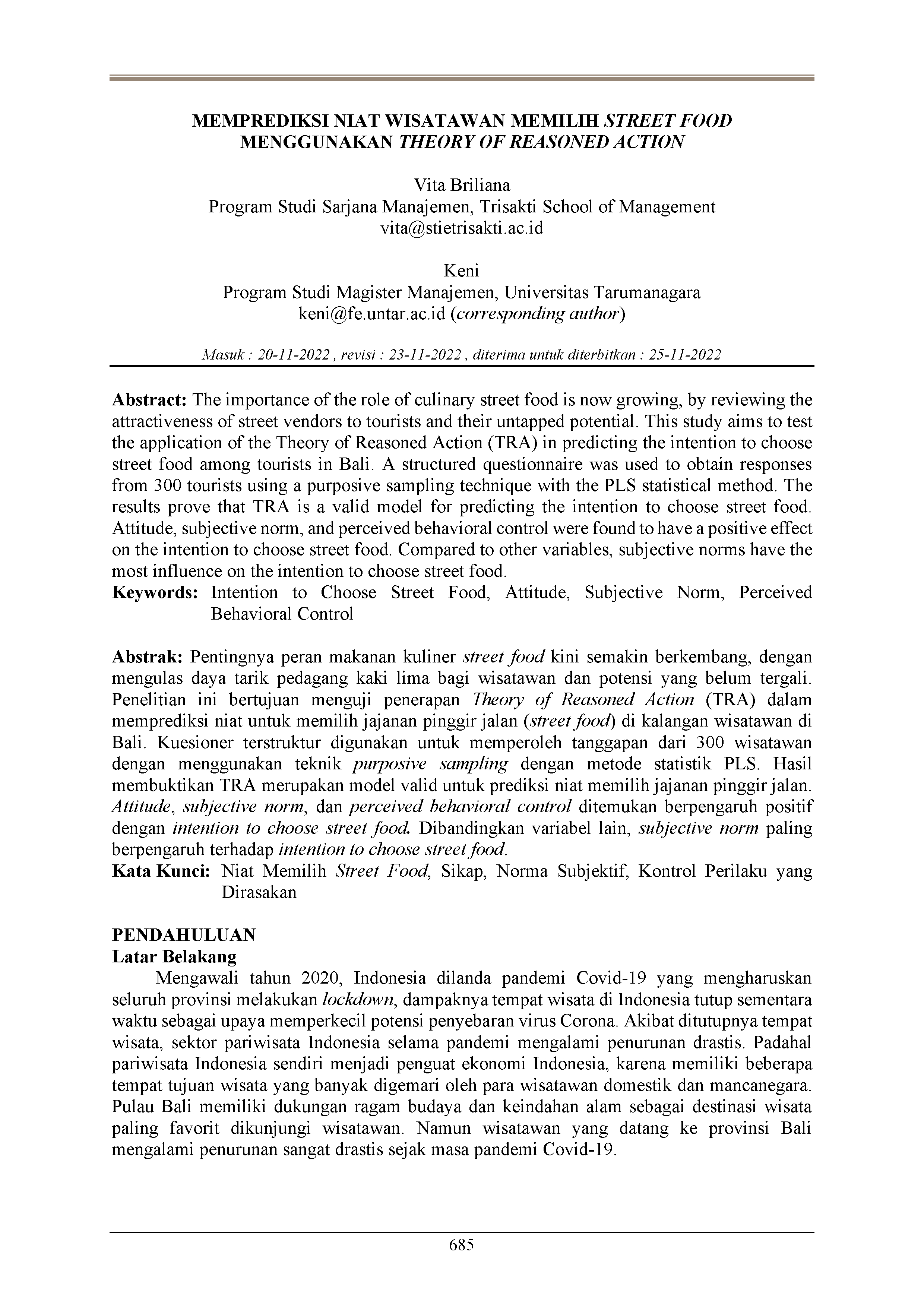Memprediksi Niat Wisatawan Memilih Street Food Menggunakan Theory of Reasoned Action
Isi Artikel Utama
Abstrak
The importance of the role of culinary street food is now growing, by reviewing the attractiveness of street vendors to tourists and their untapped potential. This study aims to test the application of the Theory of Reasoned Action (TRA) in predicting the intention to choose street food among tourists in Bali. A structured questionnaire was used to obtain responses from 300 tourists using a purposive sampling technique with the PLS statistical method. The results prove that TRA is a valid model for predicting the intention to choose street food. Attitude, subjective norm, and perceived behavioral control were found to have a positive effect on the intention to choose street food. Compared to other variables, subjective norms have the most influence on the intention to choose street food.
Pentingnya peran makanan kuliner street food kini semakin berkembang, dengan mengulas daya tarik pedagang kaki lima bagi wisatawan dan potensi yang belum tergali. Penelitian ini bertujuan menguji penerapan Theory of Reasoned Action (TRA) dalam memprediksi niat untuk memilih jajanan pinggir jalan (street food) di kalangan wisatawan di Bali. Kuesioner terstruktur digunakan untuk memperoleh tanggapan dari 300 wisatawan dengan menggunakan teknik purposive sampling dengan metode statistik PLS. Hasil membuktikan TRA merupakan model valid untuk prediksi niat memilih jajanan pinggir jalan. Attitude, subjective norm, dan perceived behavioral control ditemukan berpengaruh positif dengan intention to choose street food. Dibandingkan variabel lain, subjective norm paling berpengaruh terhadap intention to choose street food.
Rincian Artikel

Artikel ini berlisensiCreative Commons Attribution-NonCommercial-ShareAlike 4.0 International License.
This work is licensed under a Jurnal Manajemen Bisnis dan Kewirausahaan Creative Commons Attribution-ShareAlike 4.0 International License.
Referensi
Ajzen, I. (1991). The theory of planned behavior. Organizational Behavior and Human Decision Processes, 50(2), 179–211. https://doi.org/10.1016/0749-5978(91)90020-T
Al-Swidi, A., Huque, S. M. R., Hafeez, M. H., & Shariff, M. N. M. (2014). The role of subjective norms in theory of planned behavior in the context of organic food consumption. British Food Journal, 116(10), 1561–1580. https://doi.org/10.1108/BFJ-05-2013-0105
Badan Pusat Statistik Provinsi Bali. (2022). Banyaknya wisatawan mancanegara bulanan ke Bali menurut pintu masuk (orang), 2022. Badan Pusat Statistik Provinsi Bali. https://bali.bps.go.id/indicator/16/106/1/banyaknya-wisatawan-mancanegara-bulanan-ke-bali-menurut-pintu-masuk.html
Bagozzi, R. P., Wong, N., Abe, S., & Bergami, M. (2000). Cultural and situational contingencies and the theory of reasoned action: Application to fast food restaurant consumption. Journal of Consumer Psychology, 9(2), 97–106. https://doi.org/10.1207/S15327663JCP0902_4
Burton, S., & Creyer, E. H. (2004). What consumers don’t know can hurt them: Consumer evaluations and disease risk perceptions of restaurant menu items. Journal of Consumer Affairs, 38(1), 121–145. https://doi.org/10.1111/j.1745-6606.2004.tb00468.x
Chavarria, L. C. T., & Phakdee-auksorn, P. (2017). Understanding international tourists’ attitudes towards street food in Phuket, Thailand. Tourism Management Perspectives, 21, 66–73. https://doi.org/10.1016/j.tmp.2016.11.005
Cohen, E., & Avieli, N. (2004). Food in tourism: Attraction and impediment. Annals of Tourism Research, 31(4), 755–778. https://doi.org/10.1016/j.annals.2004.02.003
Fishbein, M. A., & Ajzen, I. (1975). Belief, attitude, intention and behaviour: An introduction to theory and research. Addison-Wesley.
Hair Jr., J. F., Risher, J. J., Sarstedt, M., & Ringle, C. M. (2019). When to use and how to report the results of PLS-SEM. European Business Review, 31(1), 2–24. https://doi.org/10.1108/EBR-11-2018-0203
Japutra, A., & Keni. (2020). Signal, need fulfilment and tourists’ intention to revisit. Anatolia, 31(4), 605–619. https://doi.org/10.1080/13032917.2020.1806889
Keni, & Japiana, M. (2022). Factor influencing brand loyalty in the Indonesian food and beverage sector. Jurnal Manajemen, 26(2), 277–295. https://doi.org/10.24912/jm.v26i2.980
Keni, Oktora, F., & Wilson, N. (2018). The impact of destination image and perceived quality on tourist loyalty in the Indonesia tourism industry. Proceedings of the 7th International Conference on Entrepreneurship and Business Management, 67–75. https://doi.org/10.5220/0008488300670075
Kim, E., Ham, S., Yang, I. S., & Choi, J. G. (2013). The roles of attitude, subjective norm, and perceived behavioral control in the formation of consumers’ behavioral intentions to read menu labels in the restaurant industry. International Journal of Hospitality Management, 35, 203–213. https://doi.org/10.1016/j.ijhm.2013.06.008
Lada, S., Harvey Tanakinjal, G., & Amin, H. (2009). Predicting intention to choose halal products using theory of reasoned action. International Journal of Islamic and Middle Eastern Finance and Management, 2(1), 66–76. https://doi.org/10.1108/17538390910946276
Lee, T. H. (2009). A structural model to examine how destination image, attitude, and motivation affect the future behavior of tourists. Leisure Sciences, 31(3), 215–236. https://doi.org/10.1080/01490400902837787
Lutz, R. J. (1991). The role of attitude theory in marketing. In H. H. Kassarjian & T. S. Robertson (Eds.), Perspectives in Consumer Behavior (4th ed., pp. 317–339). Prentice Hall.
Pratama, D. B., & Briliana, V. (2022). Anteseden destination loyalty: Studi empiris pada wisatawan domestik Candi Borobudur. Jurnal Muara Ilmu Ekonomi dan Bisnis, 6(1), 1–12. https://doi.org/10.24912/jmieb.v6i1.13426
Rodriguez, E., Lacaze, V., & Lupin, B. (2007). Willingness to pay for organic food in Argentina: Evidence from a consumer survey. 105th EAAE Seminar ’International Marketing and International Trade of Quality Food Products, 187–213. https://ageconsearch.umn.edu/record/7873/files/cp070012.pdf
Sparks, P., & Shepherd, R. (1992). Self-identity and the theory of planned behavior: Assesing the role of identification with “green consumerism.” Social Psychology Quarterly, 55(4), 388–399. https://doi.org/10.2307/2786955
Tarkiainen, A., & Sundqvist, S. (2005). Subjective norms, attitudes and intentions of Finnish consumers in buying organic food. British Food Journal, 107(11), 808–822. https://doi.org/10.1108/00070700510629760
Thøgersen, J. (2009). The motivational roots of norms for environmentally responsible behavior. Basic and Applied Social Psychology, 31(4), 348–362. https://doi.org/10.1080/01973530903317144


